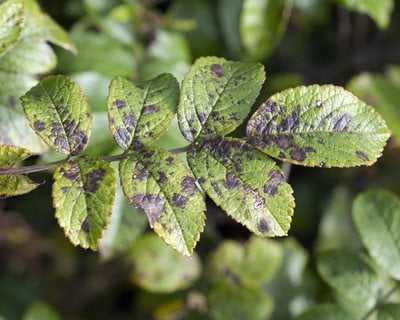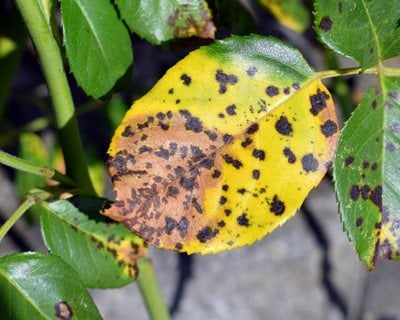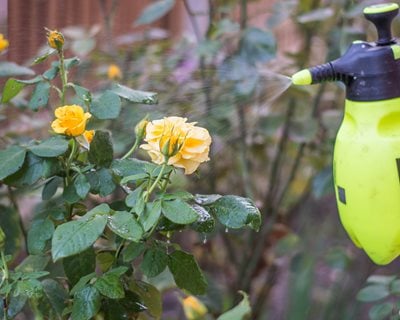How to Treat & Prevent Black Spot on Roses
Seeing black spots on rose leaves? Learn what causes them and how to stop the spread.
Photo by Manfred Ruckszio / Shutterstock.com
If rose growers had a public enemy number one, it would surely be black spot—a menacing fungal disease best known for causing black spots on rose leaves. Once this disease takes hold, it can be difficult to control and may weaken your plants over time. Use these tips to control black spot and reduce its effect on the health, beauty, and longevity of your plants.
On this page:- What are the symptoms of black spot?
- What causes black spot?
- How to prevent black spot
- How to treat black spot
- How does black spot spread?
- Which roses are more susceptible to black spot?
- Which roses are more resistant to black spot?
WHAT ARE THE SYMPTOMS OF BLACK SPOT?
As the name implies, the first signs of black spot are irregularly shaped spots up to 1/2 inch in diameter, especially on the upper leaf surface. As the disease worsens, the leaves begin to yellow and eventually drop from the plant prematurely, usually beginning at the bottom and progressing upward. Over time, the entire plant may become defoliated and the canes can become infected as well.
WHAT CAUSES BLACK SPOT?
Like most fungal plant diseases, black spot (caused by the fungus Diplocarpon rosae) is brought on by a wet, humid environment and cool temperatures, conditions most likely to occur early in the growing season. If left unchecked, the loss of leaves can weaken your plants and inhibit bloom development.
Black spot usually won’t kill your plants during the first year or two. However, if it continues unabated, it can weaken them, making them more susceptible to other diseases, such as rose rosette, and less likely to survive harsh winters.

The progression of black spot disease to yellowing leaves. Photo by matunka / Shutterstock.com
HOW TO TREAT BLACK SPOT

Photo by Yulia Derid / Shutterstock.com
Once you see the telltale signs of black spot, you can’t reverse the disease, but you can stop it from spreading to new leaves. The key to success with any treatment is consistency. Follow these quick steps to stop the spread:
- Start early: Begin spraying in early spring, before symptoms appear.
- Respray regularly: Apply treatment every 7 to 14 days, and always after a heavy rain.
- Spray thoroughly: Cover the tops and undersides of the leaves, as well as the stems and canes.
- Use a dormant spray: In winter, apply a dormant spray to smother overwintering fungal spores.
In addition to spraying, using the right fungicides or homemade remedies can help manage outbreaks and prevent future infections.
Fungicide: There are a number of environmentally friendly organic products that can help suppress black spot, including sulfur, neem oil, and copper-based sprays. These are widely available as foliar sprays or dusting powders and are effective against many fungal diseases. (Read more on how to use neem oil.)
Home remedies: In a pinch, you can make your own antifungal spray for treating black spot using common kitchen ingredients. A Cornell University researcher demonstrated that a mixture developed for powdery mildew—1 tablespoon of baking soda mixed in a gallon of water, with a bit of horticultural oil or liquid soap added to help it cling to the leaves—may also reduce the spread of black spot when used consistently.
Some gardeners report success with other DIY sprays made from diluted milk, vinegar, or hydrogen peroxide. These homemade remedies may be worth a try, but research on their effectiveness is limited.
For additional tips on organic fungicides and a list of commercially available products, see this Purdue University Extension guide.
HOW TO PREVENT BLACK SPOT
Black spot can be difficult to control once it's established. The best defense is early, consistent care. Follow these steps to prevent infection:
- Keep foliage dry: Spores need moisture to germinate. Avoid overhead watering whenever possible.
- Water early: If using overhead watering, do it early in the day so leaves can dry before nightfall.
- Improve air circulation: Space your roses properly and prune them regularly to reduce humidity around leaves.
- Choose a sunny location: Sunlight helps dry moisture quickly, making it harder for spores to take hold.
- Remove infected leaves promptly: Dispose of diseased foliage as soon as you notice symptoms to prevent spread.
- Prune back infected canes: Cut out and discard any visibly affected stems to reduce fungal buildup.
- Clean up in fall: Remove all fallen leaves and plant debris to prevent spores from overwintering and returning in spring.
Pro Tip: Denise Kelly of Variegata Studios also suggests spraying rose bushes with liquid kelp to strengthen the leaf cuticle and make them more resistant to disease.
HOW DOES BLACK SPOT SPREAD?
Black spot spores are primarily spread from leaf to leaf and plant to plant by wind, but they won’t germinate without the presence of moisture. That’s why wet and humid conditions, especially over a prolonged period of time, are ideal conditions for black spot to take hold and spread freely.
WHICH ROSES ARE MORE SUSCEPTIBLE TO BLACK SPOT?
All types of roses are fair game for black spot, but some cultivars are much more susceptible than others. The roses most resistant to the disease include floribundas, shrub roses, and climbing roses, while the least resistant are hybrid tea roses, grandifloras, and miniature roses, according to University of Nebraska-Lincoln Extension. In general, rose bushes with dense foliage or those with leaves that grow close to the ground are more prone to infestation than roses with an open, airy canopy.
WHICH ROSES ARE MORE RESISTANT TO BLACK SPOT?
Often the best approach to eliminating black spot in the garden is to replace your most vulnerable roses with newer disease-resistant hybrids, advises Peter Kukileski, author of Roses Without Chemicals, which lists 150 rose varieties that excel in gardens without the use of pesticides. They're also less susceptible to other common fungal ailments, such as powdery mildew, rust, and anthracnose.
The degree of resistance can vary depending on plant care, site conditions, and the local environment, but in most cases your disease-resistant roses won’t suffer much even if they do get black spot. "Some varieties of roses have a tendency that if they do get some black spot on their leaves, they won’t defoliate. The genetics of the plant are strong enough to keep the leaves on the plant even with disease,” says Kukileski.
ABOUT THE AUTHOR
Anne Balogh is a longtime gardening writer and editor for Garden Design, with over 20 years of experience covering everything from container planting to landscape trends. She draws inspiration from her own Zone 5 garden in Illinois, where she experiments with hardy perennials and flowering annuals.
RELATED:
How to Prune Roses
How to Get Rid of Powdery Mildew
How to Fertilize Roses
